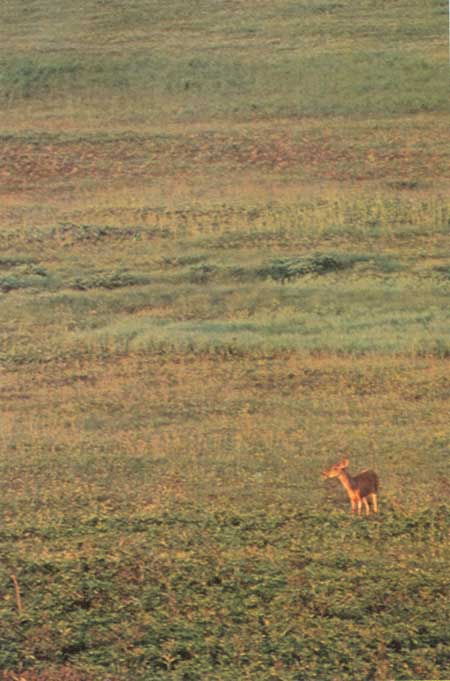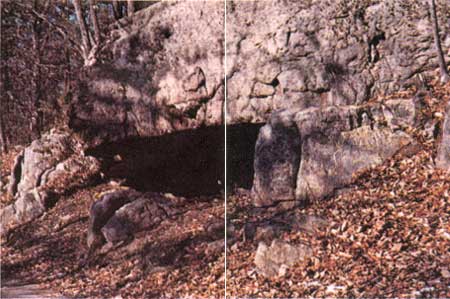|
SHENANDOAH National Park |
 |
The Indian Era
"If I were an Indian, I'd sit under this oak tree waiting for game." Assistant Chief Naturalist Bruce McHenry got nods of agreement from the group of visitors he had led out along the quartzite backbone of Rocky Mountain. Along the way, he had told them how Indians once used these ridges as sources of stone for weapon points and, no doubt, as lookouts. Now, having absorbed the view from a projecting outcrop and having tried to imagine themselves Indians, the hikers were filing back toward Skyline Drive. The naturalist had hardly made his comment about sitting under the oak tree when he suddenly stopped, bent down, and with a triumphant smile picked up a perfect quartz arrowhead. In one instant the yesteryear he had been trying to evoke became real. The walk was "made." That night at the campfire program they were still talking about it. One man teased McHenry: "You really planted it there, didn't you?"
Such finds are not unusual. Around Big Meadows, on Lewis Mountain and Tanner's Ridge, at Hawksbill and Pinefield Gaps, and in many other places, arrowheads, spear points, stone knives and other clues confirm the long use of the Blue Ridge by Indians. The nature of these tools further tells us that the Blue Ridge was primarily a hunting ground, rather than a place of settlement. Aside from one fragment of a pot (indicating food or water storage) found in a rock shelter on Madison Run, and some burial mounds (suggesting the site of a village) found near Jarman Gap, there is no evidence that Indians established other than temporary hunting camps in these mountains. And this use of the land is not surprising. It was only natural that the Indians should choose the lowlands, with both fertile soil and an equable climate, for settlement.
 Big Meadows was an important hunting ground for the Indians. (Photo by Hugh Crandall) |
The tide of man's migration into North America (apparently by way of the Bering land bridge) reached the Shenandoah area at least 10,000 and perhaps 13,000 years ago. For the first 9,000 or more years of their existence here, the Indians were hunters and gatherers, moving to wherever they could find food. About 3,000 years ago, they learned how to make clay pottery. Then, about 1,000 years ago, the revolutionary discovery, made by tribes in Mexico, that food plants could be domesticated and raised at chosen places finally reached the Indians of Shenandoah. At about the same time, they learned the use of bow and arrow. After these culture-shaking introductions, hunting, fishing, and gathering of wild foods gradually became supplementary activities carried on from their villages near fields of corn, squash, gourds, and beans.
The Valley and Piedmont scene in late Indian days, as reported by early explorers, was a patchwork of fields and forests, perhaps not greatly different from today's pattern. The open places were gardens, some dotted with the stubs of girdled and burned trees, and grassy expanses made by Indian fires and perhaps by the filling in of beaver ponds. Herds of elk and bison grazed on the manmade savannas. Though his lowland environment was fruitful, the Indian still saw value in the mountains rising above him. Following game trails, he easily gained the upper elevations, where he hunted deer, bear, and elk. As in the valleys, he found that he could encourage and concentrate game by burning the forest on some of the more level mountaintops, producing grassy openings dotted with berry bushes and small trees.
 Artifacts found in Madison Run Rock Shelter show that the cave was used by Indians. (Photo by E. R. Shaffner) |
Such a place was Big Meadows. The open expanse one now looks out upon from Byrd Visitor Center probably owes its origin to Indian fires. In the early morning or evening hours, we can easily imagine a bronze form behind a tree at the edge of the meadow, pulling back a bowstring and sending an arrow into a grazing buck. With a little more effort, we can see a line of braves following a great circle of fire around the meadow, driving a milling herd of terrified animals to their death.
In our day of swarming population and all-powerful technology, we rightfully worry about man's relationship with his environment. Is he destroying it, and himself with it? And sometimes we wonder if our predecessors had better ways of living with the land. Indians, it is safe to conclude, lived with the Blue Ridge for centuries without destroying it, all that time drawing food, clothing, and shelter from its many forms of life. They had, of course, some constraints built into their way of life that we don't have. One was a low density of population, which was dictated by high death rates, the difficulty of storing surplus food, and perhaps self-imposed limits on their numbers. Another constraint was the nature of the tools they had to work with: bows, hoes, and stone axes certainly can't compete with guns, tractors, and bulldozers as resource—exploiting implements. (Fire, in their hands, could be considered productive rather than destructive, maintaining grass and shrubs but not burning deeply into the soil.) The Indians were thus too few and too ill-equipped to have long-term deleterious effects on the land. But though their situation and ours are not really comparable, we can still learn from them. We can learn, as Indians did from direct dependence on the natural world, to understand and respect the many forms of life and their environments. For our dependence, though obscured by the complex organization of modern society, is no less real.

|

|
| NPS History | History & Culture | National Park Service | Contact |
|
Last Modified: Sat, Nov 4 2006 10:00:00 pm PST |


